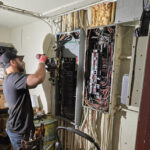How to Troubleshoot Common Electrical Issues at Home
Electrical problems can be frustrating and sometimes dangerous. Understanding how to troubleshoot common issues helps homeowners maintain a safe and functional electrical system. While some problems require professional assistance, many can be resolved with simple troubleshooting steps.
Identifying Electrical Problems
Before attempting any repairs, it is important to identify the issue. Common electrical problems include flickering lights, tripped breakers, faulty outlets, and power surges. Recognizing the signs helps determine the best course of action.
Troubleshooting Flickering Lights
Flickering lights can indicate loose wiring, a faulty bulb, or voltage fluctuations. Start by checking the bulb and replacing it if necessary. If the issue persists, inspect the fixture for loose connections. If multiple lights flicker, the problem may be with the electrical panel.
Resetting Tripped Circuit Breakers
A tripped breaker occurs when too much electricity flows through a circuit. Locate the electrical panel and identify the tripped breaker. Switch it off completely, then turn it back on. If the breaker trips repeatedly, unplug unnecessary devices and try again. Persistent issues may require professional inspection.
Fixing Faulty Outlets
Non-working outlets can result from loose wiring, a tripped GFCI outlet, or a damaged receptacle. First, check nearby outlets for a reset button and press it. If that does not work, turn off the power and inspect the wiring. Loose connections should be tightened, but damaged outlets should be replaced.
Addressing Power Surges
Power surges can damage appliances and electronics. They often occur due to lightning strikes, faulty wiring, or overloaded circuits. Installing surge protectors helps prevent damage. If surges happen frequently, an electrician should inspect the wiring for potential hazards.
Ensuring Electrical Panel Safety
The electrical panel controls power distribution throughout the home. Regular inspections help prevent hazards. Before working on the panel, turn off the main breaker and use a voltage tester to confirm power is off. Wear insulated gloves and use insulated tools for added safety.
Preventing Overloaded Circuits
Overloaded circuits can cause breakers to trip and outlets to overheat. Avoid plugging too many devices into one outlet. If circuits frequently overload, consider upgrading the electrical system to handle higher capacity.
Checking for Loose Wiring
Loose wiring can lead to electrical failures and fire hazards. If outlets or switches feel warm, turn off the power and inspect connections. Tighten loose wires carefully, ensuring proper insulation remains intact.
When to Call a Professional
While many electrical issues can be resolved with basic troubleshooting, some require expert assistance. If problems persist or involve exposed wiring, burning smells, or frequent power outages, contact R&B Coastal Electric at (239) 237-8217 for professional service.
Trust R&B Coastal Electric for Reliable Solutions
At R&B Coastal Electric, highly skilled electricians provide expert troubleshooting and repairs. Their commitment to excellence ensures safe and efficient electrical solutions for homeowners.
Maintain a Safe and Functional Electrical System
Regular inspections and proper troubleshooting help prevent electrical hazards. By following these steps, homeowners can address common issues and maintain a reliable electrical system.
For expert electrical services, contact R&B Coastal Electric at (239) 237-8217 today. Their team is ready to assist with all electrical needs!

